LEARNING TO LOVE READING LEARNING TO LOVE READING

















7 FAMILY-FRIENDLY FALL EVENTS
FALL 2023
RECONSIDERING THE RACE TO THE SUMMIT BOOKS THAT TEACH RESILIENCE
BROUGHT TO YOU BY






















































k1-ECHO082323.indd 1 8/18/23 10:45 AM KIDS VT FALL 2023 2












BREAKFAST, LUNCH, DINNER & DESSERT MADE EASY 7 DAYS A WEEK AT A SKINNY PANCAKE NEAR YOU @SKINNYPANCAKE | SKINNYPANCAKE.COM BREAKFAST, LUNCH, DINNER & DESSERT MADE EASY BTV AIRPORT BURLINGTON WATERFRONT MONTPELIER QUECHEE STOWE VILLAGE SPRUCE PEAK @ STOWE MTN. UNIVERSITY OF VERMONT ALBANY, NY k2h-SkinnyPancake0523 1 5/17/23 2:35 PM VERMONT Living History Expo buy tickets at the gate or at: VTGatherings.com 3rd Annual Sept 23 & 24, 2023 • Champlain Valley Expo History for the Whole Family! All ages event with live demos, dispL ays, vendors & more! k4t-VTGatherings082323 1 8/10/23 3:59 PM pure fun! fun! We ENHANCE mountain bike skill sets while exploring the Northeast Kingdom We CREATE lifelong passion We ENGAGE in concepts of nutrition, sport physiology, and psychology kingdomcamp s. c mo V I SITUS AT 2024Registration OPENS ON FEBRUARY 1! k4t-KingdomCamps082323.indd 1 8/18/23 1:57 PM KIDS VT FALL 2023 3
Braces for Children & Adults





FALL IN LOVE WITH A NEW SMILE


Whether you’re considering clear aligners, retainers or today’s braces, an orthodontist is the smart
Re-imagining Education for the 21st Century








Academic Excellence & Inspired Learning Leadership STEM Outdoor Education

























k2v-BoltonValley082323 1 8/17/23 4:53 PM
Family acceptance matters.

We




out our youth and families
• Friday Night Group • Gender Creative Kids • QTBIPOC • Trans Group • And more! Find resources at outrightvt.org. KidsVT_OutrightVT_FullPage_August2023.indd 1 8/10/23 6:41 AM k1-RedhairMedia(OutrightVT)082323 1 8/10/23 12:49 KIDS VT FALL 2023 5
all want our kids to be happy and healthy. Research shows that family acceptance leads to better well-being and health for LGBTQ+ youth. You can make all the difference. Believe in your child. Believe in yourself. It will power them through life. Check
groups!





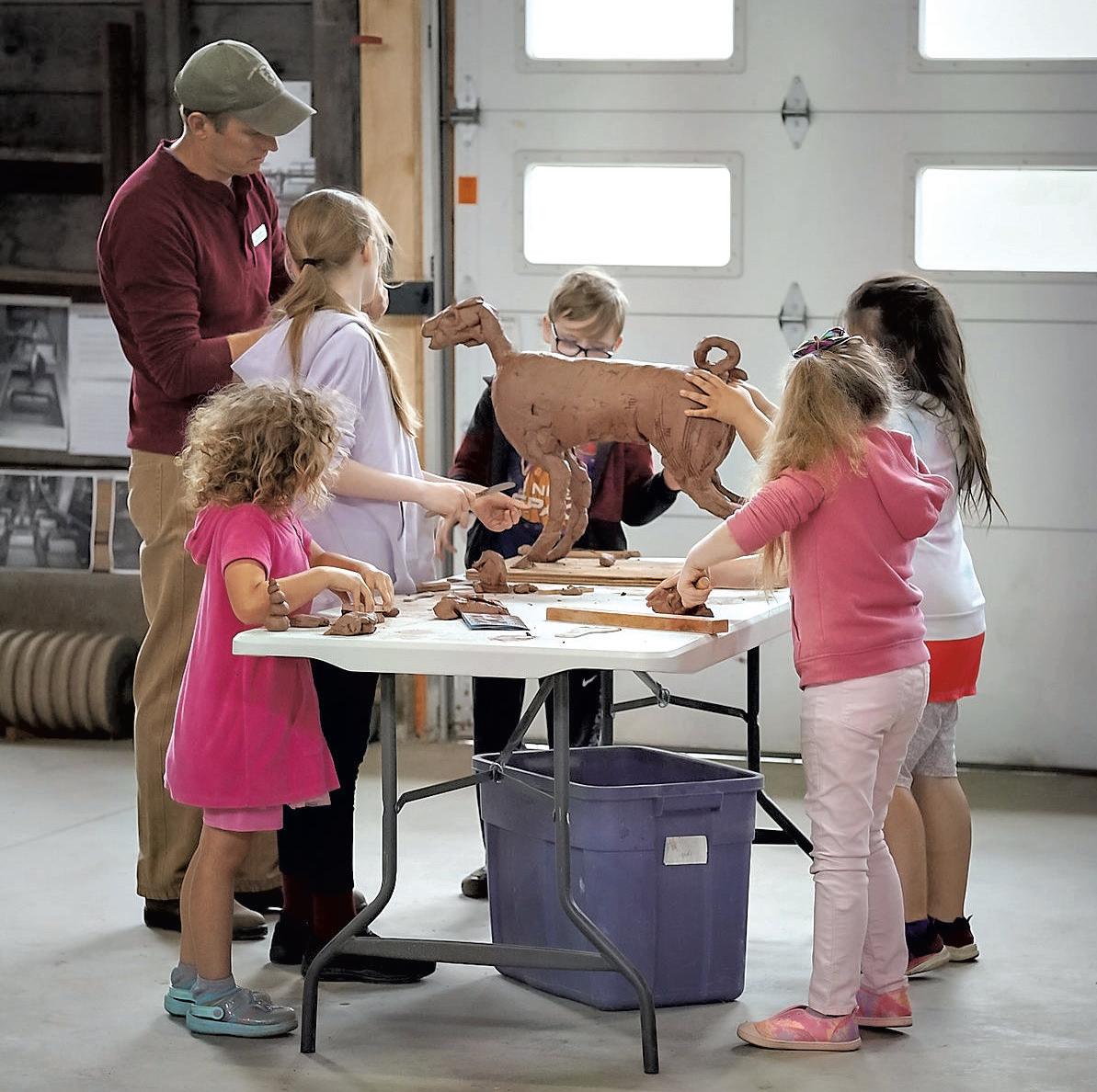


START YOUR KIDS ON THE RIGHT TRACK WITH A STUDENT CHECKING ACCOUNT INSURED BY NCUA *No monthly service or overdraft fees and no minimum balance requirement. Must be a member of the credit union to open a student checking account. No fees or minimums* FREE Debit card ATM Access Online & Mobile Banking Automatically converts into Reward Checking account at age 18 Parent or guardian is joint on the account Financial literacy is an important part of your child’s education. A Student Checking account, specifically for 13-17 year olds, can assist them in developing responsible habits today to ensure that they make sound financial decisions tomorrow. k2h-VFCU082323.pdf 1 8/10/23 3:26 PM KIDS VT FALL 2023 6 Join the Vermont Granite Museum for its annual Granite Festival! Enjoy hands-on activities, demonstrations by granite carvers, music, and food. Premiere newly-digitized historic films focused on Vermont’s granite industry. ADMISSION IS FREE! VERMONT GRANITE MUSEUM GRANITE FESTIVAL Saturday, October 14, 10AM–4PM 7 Jones Brothers Way, Barre vtgranitemuseum.org • (802) 476-4607 PHOTOGRAPHS BY DREAM ANCHOR PHOTOGRAPHY k2h-VTGraniteMuseum082323.indd 1 8/17/23 2:40 PM
COPUBLISHER/EDITOR
Cathy Resmer cathy@sevendaysvt.com
COPUBLISHER

Colby Roberts
colby@sevendaysvt.com
CONSULTING EDITORS
Carolyn Fox
Sasha Goldstein
Alison Novak
ART DIRECTOR
Kirsten Thompson
MULTIMEDIA JOURNALIST
Cat Cutillo cat@sevendaysvt.com
EVENTS DIRECTOR
Katie Olson katie@sevendaysvt.com
ACCOUNT EXECUTIVE








Kaitlin Montgomery kaitlin@kidsvt.com
PROOFREADERS
Martie Majoros
Angela Simpson
PRODUCTION MANAGER
John James
CREATIVE DIRECTOR
Don Eggert
DESIGNERS
Jeff Baron
John James
Rev. Diane Sullivan
CIRCULATION MANAGER
Matt Weiner
BUSINESS MANAGER
Marcy Stabile
CONTRIBUTING WRITERS
Gillian English
Heather Fitzgerald
Emily Hamilton
Elisa Järnefelt
Astrid Hedbor Lague
Ken Picard
PHOTOGRAPHERS
Luke Awtry
Daria Bishop
Andy Brumbaugh
James Buck
P.O. BOX 1164 • BURLINGTON, VT 05401 802-985-5482 • SEVENDAYSVT.COM/KIDSVT
Published 4x per year.
Circulation: 43,000 at 800 locations throughout northern and central Vermont.
© 2023 Da Capo Publishing Inc. All rights reserved.
Editorial content in Kids VT is for general informational purposes. Parents must use their own discretion for following the advice in any editorial piece. Acceptance of advertising does not constitute service/product endorsement.
Da Capo Publishing shall not be held liable to any advertiser for any loss that results from the incorrect publication of its advertisement. If a mistake is ours, and the advertising purpose has been rendered valueless, Da Capo Publishing may cancel the charges for the advertisement, or a portion thereof as deemed reasonable by the publisher. Da Capo Publishing reserves the right to refuse any advertising, including inserts, at the discretion of the publishers.
The Best Present
When friends, relatives or coworkers share the happy news that they’re about to welcome their first baby, I have a standard gift for them: books. My go-to titles are the ones I first read to my own kids — board books including Everywhere Babies by Susan Meyers and selections from Sandra Boynton’s animal-themed oeuvre such as Moo, Baa, La La La! and But Not the Hippopotamus

I can recite most of them from memory.
I cherished the nighttime ritual of sitting on my kids’ beds and reading them a story, and I think they did, too. When they were older and the books became more complex, I’d do voices for di erent characters.
Now teenagers, Graham and Ivy barely remember that my wife and I read to them every night for years. Our consolation: Both of them now choose and read books on their own. That was the goal, after all.
Reading isn’t just a fun hobby — it opens our minds and provides an escape from reality. Books stretch our imaginations. They help us make sense of the world.
Helping kids learn to read — and learn to love reading — is one of the most important legacies we can leave them. It sets them up for success in school, and in life.
That’s not just my gift-giving philosophy; it’s also the message of the Waterbury-based Children’s Literacy Foundation. The nonprofit works to inspire a love of reading in Vermont and New Hampshire kids ages 12 and under. For 25 years, CLiF has been giving new books to kids and partnering with schools and libraries to expand their literacy programming.
For this Fall “Back to School” issue, Seven Days sta er Gillian English sat down with CLiF’s new executive director — Laura Rice, who recently took over from founder Duncan McDougall — to talk about building childrens’ literacy skills (page 18).
One of the strategies Rice recommends: taking a weekly trip to the library to pick out new books. During the editing process, English revealed that she had that experience with her mom. “Every Wednesday we’d go to the library after school. I’d return the books I’d read and get new ones,” she said.
English spent a lot of time at the library and even met one of her best friends at a library story hour when they were preschoolers. It had a lasting impact — she studied writing at Champlain College and writes for Seven Days’ 7D Brand Studio.

Libraries have played a central role in this summer’s Good Citizen Challenge. Visiting a library is the activity in the center square of the 2023 Challenge scorecard. You can see some of the work we’ve received on page 22. There’s still time to complete the Challenge before the September 4 deadline to be eligible for the grand prize — a free trip to Washington, D.C.
Post-Labor Day, fall family events abound. Find a few of them in Seven Days calendar writer Emily Hamilton’s “Save the Dates” on page 15. And during this hectic back-to-school season, consider Heather Fitzgerald’s advice about giving yourself permission not to summit (page 31). It’s not just applicable to hiking.
As our family calendar fills up, I’m constantly reminding myself not to be too ambitious in scheduling our remaining down time. Instead of climbing to the top of the mountain, we might be better o relaxing in the hammock — with a good book.
CATHY RESMER, EDITOR/COPUBLISHER
Growing up, what was your favorite book?
LITTLE HOUSE IN THE BIG WOODS by Laura Ingalls Wilder! Perhaps my obsession as a New York City kid with log cabins and sugaring o parties foreshadowed my move to Vermont as an adult...
EMILY HAMILTON, CONTRIBUTOR
I didn’t have just one favorite book, I had four, all by A.A. Milne — two poetry and two WINNIE-THE-POOH. They meant so much to me that I got two illustrations from the books tattooed on my body. And I still have the books!

DIANE SULLIVAN, DESIGNER
HALF MAGIC by Edward Eager. A group of kids find a charm that grants their wishes — but only half of them, and the half is unpredictable. It wasn’t until I went to buy the book to read to my kids that I found out it was part of a series of seven books! What a gift!
ASTRID HEDBOR LAGUE, CONTRIBUTOR
Norton Juster’s THE PHANTOM TOLLBOOTH, illustrated by Jules Fei er. I read it several times in second grade. I didn’t fully appreciate some of Juster’s wordplay until years later!




CATHY
RESMER, EDITOR COPUBLISHER
One of the books that stands out the most from my childhood is THE PRINCESS BRIDE by William Goldman. Way before there was a movie, this book and my imagination transported me to an exciting world of adventure, romance and mystery!
 COLBY ROBERTS, COPUBLISHER
COLBY ROBERTS, COPUBLISHER
STAFF QUESTION CONTRIBUTOR’S NOTE

Gillian English is the assistant to the publishers at Seven Days She lives in South Burlington and spends her free time reading, camping and watching Formula One racing — on Sundays she’s regularly cheering on Sir Lewis Hamilton.

KIDS VT FALL 2023 7 STAFF & CONTRIBUTORS
Cathy reading to Graham for the first time
EDITOR’S NOTE

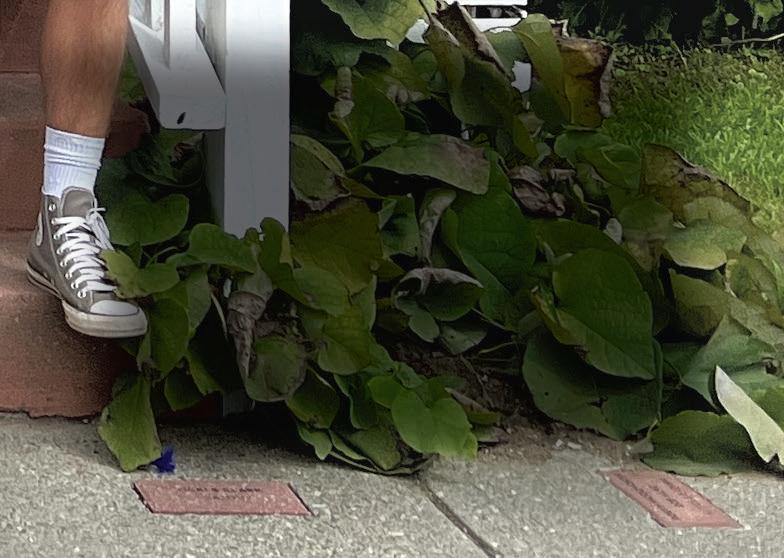
KIDS VT FALL 2023 8 DAVISSTUDIOVT.COM • 802-425-2700 • 916 SHELBURNE ROAD • SOUTH BURLINGTON Come Celebrate Davis Studio’s 20TH BIRTHDAY! SUNDAY, SEPTEMBER 10TH • 14 P.M . Food, Fun, Music, and Art-Making for all ages. Meet our teachers and tour our building. Find your happy place and your creative community! NOW ENROLLING FOR FALL CLASSES FOR YOUTH AND ADULTS. k1-DavisStudio0823.indd 1 8/17/23 10:49 AM

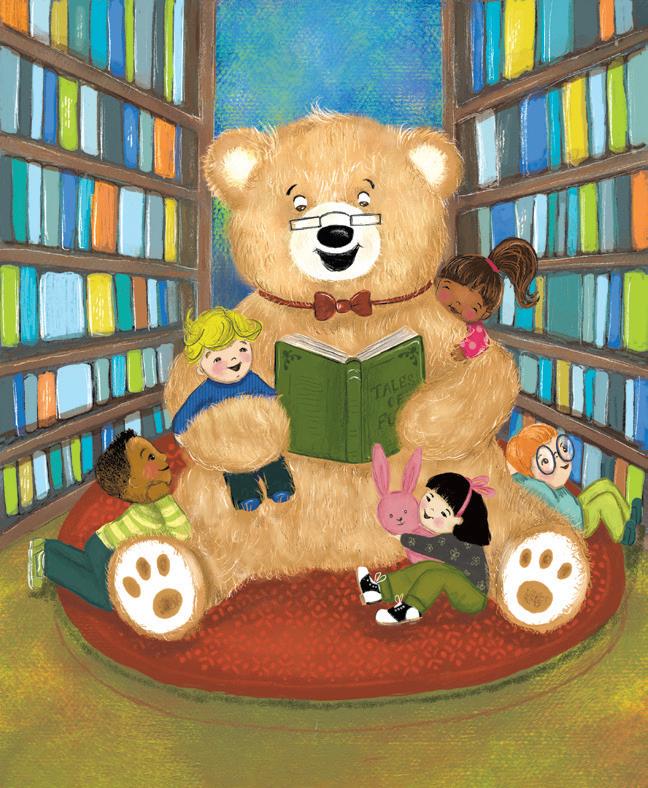































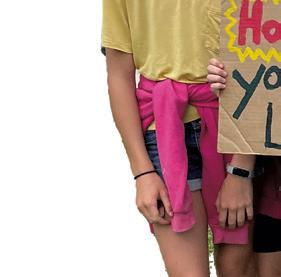

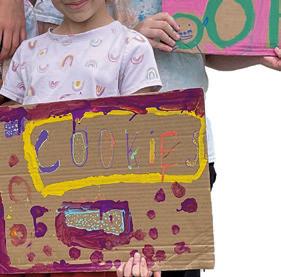


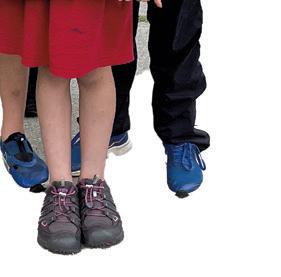







KIDS VT FALL 2023 9 On the Cover Welcome 7 Editor’s Note Staff Question Contributor’s Note Short Stuff 10 In the News Columns 13 In Case You Missed It 15 Save the Dates 16 Mealtime Cover art by Vermont illustrator Lori Duff Just for Kids 27 Coloring Contest 28 Coloring Contest Winners FALL 2023 Turning the Page The Children’s Literacy Foundation inspires kids to read, one book at a time The Same, the Di erent and the Novel A comic by Elisa Järnefelt 18 Good Citizen Challenge What can you do to improve your community? Summit Not Required Reconsidering the race to the top 22 31 24 K12v-wonderdeet082323 1 8/17/23 2:47 PM Don’t wait, book a party today! 802.872.7522 NOW OPEN! MonkeyDoPlaygrounds.com 64 Harvest Lane Williston, VT 05495 • Admission for 10 Children • Private Party Room – 2 hours • A pair of grippy socks for each guest EACH ADDITIONAL CHILD Unlimited Play Time Juice boxes, plates, cups, utensils & napkins We provide a party room assistant to help. You bring the cake, camera & kids! Jungle Party EACH ADDITIONAL CHILD Plus Everything in the Jungle Special Most Important Monkey – Birthday Kid 2 Large Pizzas Soft Serve Ice Cream Monkey Do! T-Shirt or Stuffed Monkey for MIM Funky Monkey Untitled-69 1 11/21/19 2:43 PM $300 $19 $350 $21 k6v-MonkeyDo!030123.indd 1 2/17/23 1:34 PM
BY KEN PICARD AND CATHY RESMER

UVM Researcher Helped Develop New RSV Vaccine
The pervasive respiratory disease
RSV, or respiratory syncytial virus, infects 97 percent of all children by the age of 2. Most make full recoveries, but severe RSV can cause pneumonia, bronchiolitis and permanent lung damage. It’s the leading cause of hospitalizations in all infants and toddlers, according to the U.S. Centers for Disease Control and Prevention; globally, it’s the second leading cause of death in children under age 1, behind only malaria.
Sean Diehl has been working to change that. He’s a vaccine researcher and associate professor of microbiology and molecular genetics at the University of Vermont’s Larner College of Medicine. Diehl’s lab helped develop the RSV vaccine Beyfortus (nirsevimab), which was approved by the U.S. Food and Drug Administration on July 17.
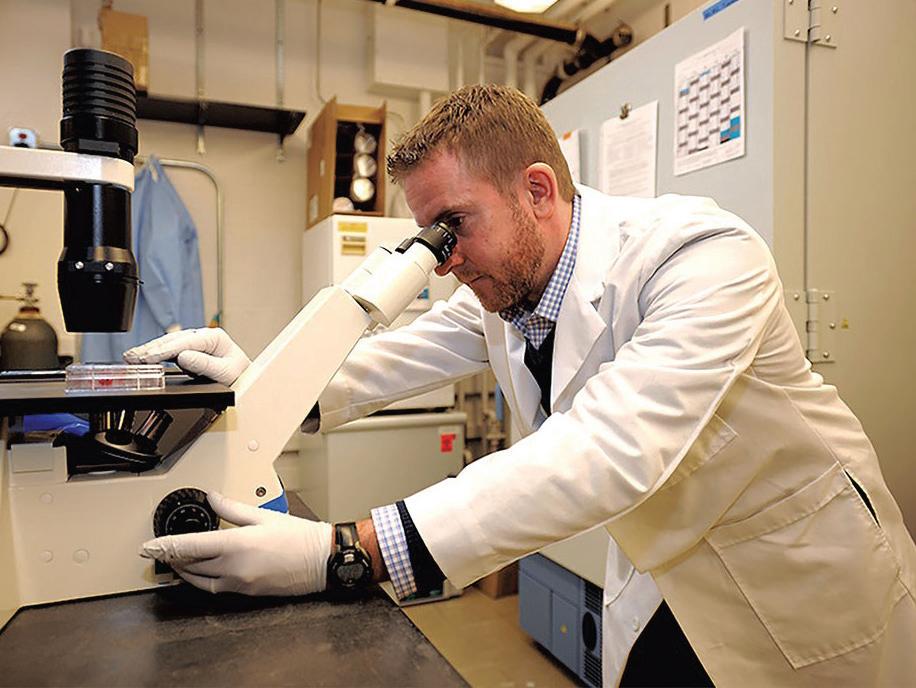
It uses a monoclonal antibody, similar to the kind used to treat patients with COVID-19, and has been deemed nearly 80 percent effective in preventing children from being hospitalized with RSV; it can be safely administered to children as young as newborns.

Diehl has collaborated with UVM’s Vaccine Testing Center since 2008 to develop immunizations for other infectious diseases, including rotavirus, dengue, Zika and COVID-19. He’s been working on this particular type of immunization method for more than two decades. Called a “passive vaccine,” it’s the first of its kind to be approved for children of all ages, he said.


As Diehl explained in an interview, most immunizations are considered “active” vaccines, meaning they use a harmless piece of a virus or bacteria to teach the body’s immune system how to recognize invading microbes, then
build an army of cells to fight them. Among the main weapons in that arsenal are antibodies. Through trial and error, the immune system selects the best antibodies to fend off the infection, then stores that information for future reference.
A passive vaccine functions differently. It uses a naturally occurring antibody that was created by the immune system of someone who had multiple exposures to RSV. Researchers then grew that person’s cells in a petri dish, which produced a variety of RSV antibodies. Diehl and his team screened thousands of those natural antibodies to select the ones that worked most effectively. The handpicked antibodies became the basis for the new vaccine.
As Diehl pointed out, naturally occurring antibodies don’t replace a baby’s own immune response, but they help it build its own defenses as it matures.
“The antibody vaccine acts alongside the baby’s immune system, which is kind of cool,” he said. “It’s like a laserguided missile that already knows, ‘This is RSV. I need to destroy it.’”
An added benefit of the new vaccine, Diehl noted, is that it’s long-acting and doesn’t require multiple injections to provide coverage through a single RSV season, when the risks of complications and hospitalization are greatest.
Last winter, hospitals around the country saw an unprecedented surge in pediatric RSV cases. Experts are predicting that this new vaccine for kids, along with a different one recently approved for adults 60 and older, will dramatically reduce RSV cases this winter.
VPA Aims to Inspire Good Sportsmanship
So-called “inspirational” videos rarely are. It’s tough to deliver an earnest message without seeming cringey. But a new spot on sportsmanship from the Vermont Principals’ Association pulls it off.
The five-and-a-half-minute message, created in conjunction with Mt. Mansfield Media, intersperses interviews with coaches and school officials with footage of fist-pumping moments in Vermont athletics. It includes multiple scenes of crowds going wild.

K.P.
People get emotional over sports — and that’s the point, says South Burlington High School principal Pat Burke. “We create the heat of the battle in order to have composure within that,” he says.
Winooski athletic director Sam Jackson asks: “If we can’t teach life skills through this game, then why are we doing it?”
The video is part of a new effort from the Vermont Principals’ Association to address bad behavior at scholastic sporting events. The past couple of years have seen high-profile incidents of racist name-calling and even violence. On January 31, an Alburgh man died on his drive home after participating in a brawl that broke out at a middle school boys’ basketball game.
In the video, Lauren Thomas, assistant executive director of the Vermont Principals’ Association, warns: “Our

adults need to be better and model [good] behavior, or we’re just not going to have sports.”

That would be a shame, she said in an interview. Scholastic-based athletics appeal to kids who otherwise might not make it through school. Sports teams provide community and a sense of belonging.
The VPA governs middle- and


KIDS VT FALL 2023 10
Sean Diehl
ECHO executive director Ted Lawson and Ted, the Vermont Teddy Bear mascot
COURTESY OF THE UNIVERSITY OF VERMONT
COURTESY OF ECHO
ECHO and Vermont Teddy Bear to Open Burlington Toy Store

Starting in September, Burlington shoppers will be able to buy games, puzzles, teddy bears and hands-on STEM toys at a new downtown gift shop, the Tinkering Turtle. All proceeds will support science education and the ECHO Leahy Center for Lake Champlain. The store will also feature a Vermont Teddy Bear design studio, where visitors can craft their own teddy bears.
The Tinkering Turtle is a collaboration between Vermont Teddy Bear and Burlington’s lakefront science center. ECHO’s director of sales and guest services, Kelsey VonDerLinn, said the organization is “thrilled” to be
opening the store with the Shelburne bear maker. “This has been a dream of ours for many years and we are enthusiastic about it coming to fruition,” he said in a press release.
In the same release, Vermont Teddy Bear CEO Bill Shouldice noted that the company got its start as a cart on the Church Street Marketplace. “I’m very pleased to be returning to downtown Burlington,” he said.
The Tinkering Turtle will occupy a retail space at 210 College Street that formerly housed Chop Shop Hair Design, which moved to South Burlington. An opening celebration is planned for September 23.
high-school sporting events;


Thomas pointed out that the video is part of a larger set of resources to help member programs, including guidance on behavioral expectations, signage at games and advice on using restorative justice practices to address harms.


Thomas is hopeful that the video’s message will spread — she sent it to

athletic directors at all 79 participating schools, and many have shared it with their teams and on social media.

As of press time, it had been viewed more than 6,000 times.



See the video at vermontthirdspace.org/video-page. C.R.

KIDS VT FALL 2023 11
Stills from the VPA’s sportsmanship video
C.R.
REGISTRATION FOR 2023/2024 IS NOW OPEN! Classes start September 5th, 2023 Comprehensive Instruction in all levels of Classical Ballet, Pointe, Variations, Progressing Ballet Technique, & Contemporary Ages 3 through Adult 39 River Road Essex Junction, VT • elanacademyofclassicalballet.com elanacademyofclassicalballet@gmail.com • Visit us on Facebook! c k4t-ElanDance0823.indd 1 8/17/23 1:52 PM







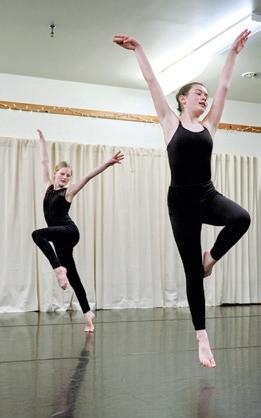




Childcare is complicated. We're here to help. If you are struggling to pay for childcare, your child may qualify for Burlington's First Steps Scholarship. Learn more at earlylearningbtv.org CITY OF BURLINGTON This program is available for Burlington residents only. k3v-EarlyLearningInitiative020123 1 1/26/23 9:08 AM An experiential reform religious school at Temple Sinai with the joy and camaraderie of summer camp! Interactive program • In-person prayer book Hebrew learning B Mitzvah prep • hands-on engagement with Reform Jewish values 500 Swi Street, South Burlington JOIN US AT OUR OPEN HOUSE ursday, September 7 4-6PM Jewish Friends Learning Together For more details, visit templesinaivt.org k3v-TempleSinai082323.indd 1 8/18/23 4:21 PM REGISTRATION OPEN! Creative Dance, Fantasy Ballet, Ballet Technique, Lyrical Jazz, Contemporary, Composition & Company Class Green Mountain Nutcracker Auditions September 16, 17 & 24 FALL SESSION 2023 MOVINGLIGHTDANCE.COM � 802.595.3606 STARTS 8/30 k6h-MovingLightDance082323.indd 1 8/18/23 11:09 AM 2 1/2 acres of Sunflowers, Zinnia, Cosmos, Celosia and so much more sculpted into a scenic, fragrant and challenging labyrinth. This is not your typical farm maze. Get lost, find yourself and reconnect … it’s magical! Open Friday, Saturday & Sunday 10 a.m.-6 p.m. Vermont’s Largest and Most Intricate Flower Maze is at Hoolie Flats Farm 1120 Pekin Brook Rd, East Calais, Vt. • 802-535-1515 • hoolieflats.com Refreshments, Snacks, and Farm Store Available k6h-HoolieFarm082323.indd 1 8/9/23 1:06 PM KIDS VT FALL 2023 12
Back to School
News Vermont families can use from Seven Days
Former Kids VT managing editor Alison Novak now covers K-12 education and childcare for our parent publication, Seven Days. As a former elementary school teacher — and the parent of two teens — Novak draws from firsthand experience to cover her beat.

Here are highlights from a few of her stories this summer, below. Follow Alison’s coverage each week in print in Seven Days and online at sevendaysvt.com.
On PCBs
From “Vermont and Its Schools Sued Over PCBs. Will They Win?,” July 19, 2023
A year after Vermont embarked on a first-in-the-nation program to test hundreds of schools for toxic airborne chemicals known as PCBs, the findings have already led to several lawsuits.
In mid-June, Vermont Attorney General Charity Clark announced that she was suing Monsanto, the sole U.S. manufacturer of PCBs, over alleged harm to Vermont’s natural resources, as well as to its schools. Less than two weeks later, 93 Vermont school districts joined as plaintiffs in a separate lawsuit against the company, seeking payment for costs associated with property damage from PCBs.
On Free Food for Kids
From “Program Sends Vermont Parents Debit Cards for Food,” July 27, 2023
Households with school-age kids are receiving Pandemic Electronic Benefit Transfer cards, which can be used to buy food from grocery stores or farmers markets. The cards — loaded with a minimum of $120 per child — come courtesy of the federal Families First Coronavirus Response Act, which is intended for pandemic recovery.
All children who attend “Community Eligibility Provision” schools — those that provide free meals to all students — are eligible to receive the money, according to Miranda Gray, deputy commissioner of the Department for Children and Families, which is administering the program.
The lawsuits, both of which charge that the agrochemical company knew that PCBs were toxic as early as the 1950s yet continued to manufacture and market them, together represent a novel tack in legal maneuvering against the oft-sued agrochemical company: trying to recoup damages for widespread contamination of schools. The latest suits follow two others filed against Monsanto last year: one by the Burlington School District for damages related to contamination of the high school and another by two Burlington High School teachers who say a variety of health problems, including miscarriage and brain fog, were caused by their schoolbased exposure to PCBs.

On Youth Mental Health From “Centerpoint, Which Educates and Counsels
Hundreds of Teens, Is Poised to Close,” July 5, 2023

Centerpoint Adolescent Treatment Services, which has long provided counseling and educational services to hundreds of at-risk young people, is scheduled to close on September 1 — even as the number of teens needing mental health support soars.
Centerpoint, which also runs a therapeutic school for teens, will shut down unless a new provider steps up, the three organizations that currently operate it said. Howard Center, Northeastern Family Institute Vermont and Matrix Health Systems blamed financial pressures for the closure; by one estimate, Centerpoint has lost $1.5 million over the past two years.
The operating partners “have been working with program leadership over the last several months to develop a new agency that could run Centerpoint,” NFI Vermont executive director Chuck Myers said in a statement. “Unfortunately, at this time that has not happened, although efforts are continuing.”
He cited “significant financial losses” over the past two years and “multiple decades of chronic underfunding of mental health and substance use services” that have made operating Centerpoint unsustainable.
Because of Vermont’s Universal School Meals Act of 2022 — which gave free breakfast and lunch to all public-school students, regardless of household income — all public schools in Vermont, and some independent ones, meet the criteria. Through the debit card program, the state will distribute a total of $9.98 million to roughly 80,000 students in 53,000 households by midAugust. Each child will receive $120, plus an additional $8.18 for each day they were absent from school due to COVID-19. The benefit will be loaded onto the card, which is printed with a 16-digit number and the name of a parent or guardian.

Families can use the benefit in one of three ways: to purchase groceries, to buy food at a local farmers market that accepts EBT or “Crop Cash,” or to purchase nonperishable food items to donate.
Any money not spent within 274 days will be returned to the federal government. If a family inadvertently throws out their card or needs a new one, they can call DCF’s Economic Services Division at 1-800-479-6151, option 7, to request a replacement. K
KIDS VT FALL 2023 13
FILE: JAMES BUCK
FILE: DIANA BOLTON
FILE: SARAH CRONIN
IN CASE YOU MISSED IT... BY ALISON NOVAK
Vermont students eating school lunch



TWO LOCATIONS! Essex Campus: 21 Carmichael Street, Suite 203 Shelburne Campus: 4066 Shelburne Road Official School of Vermont Ballet Theater, Winner of Readers Choice Award Best Ballet School, Alexander Nagiba Director. SUPERIOR CLASSICAL BALLET TRAINING VAGANOVA & BALANCHINE METHOD 202 2-23 CLASS REGISTR ATION NOW OPEN! Classes begin September 12! “Simply the Best” Main Office: 802-878-2941 vbts.org • info@vbts.org Vermont’s Own NutcrackerLIVE2021 Auditions Sept. 25! Ballet & Pointe Ages 3 years to Pre-Professional Contemporary, Jazz, STORM Competion Team VERMONT’S OWN NUTCRACKER & CELEBRATION OF DANCE AT THE FLYNN CENTER k2v-VBTS082521.indd 1 7/29/21 3:28 PM OwnVermont’sNutcracker 2023 Auditions Sept. 30! 2023-2024 CLASS REGISTRATION NOW OPEN! ENROLL AT VBTS.ORG Ballet & Pointe Ages 3 years to Pre-Professional Contemporary, Jazz, Lyrical Jazz Competition Team TWO LOCATIONS! Essex Campus 21 Carmichael Street, Suites 102 & 203 Shelburne Campus 4066 Shelburne Road Winner of “Best Dance Studio” in the Seven Daysies Main O ce: 802-878-2941 vbts.org • info@vbts.org O cial School of Vermont Ballet Theater Classes begin September 11! PERFORMANCES AT THE FLYNN 8/16/23 10:49 AM Get this year’s best back-to-school supply. Forget those new jeans and superhero lunchboxes. Confidence is the best school suppy you can give your kids. Start this year strong with a personal learning plan to fit your family’s busy back-to-school schedule — and budget. Don’t wait until it’s too late. Contact us now. SYLVAN LEARNING 1 Market Place, Unit 10, Essex 802-316-4711 SYLVANLEARNING.COM $49 Initial Diagnostic Assesment Offer valid at participating locations only. Expires 10/1/23 BRIGHT from the Get This Year's Best Back-to-School Forget those new jeans and lunchboxes. Confidence is school supply you can give Start this year strong with learning plan to fit your family's back-to-school scheduleSylvan Learning 802-316-4711 sylvanlearning.com $49 Initial Diagnostic Assessment Offer valid at participating locations Expires 10/01/22. BRIGHT from the start! Get This Year's Best Back-to-School Supply Forget those new jeans and superhero lunchboxes. Confidence is the best school supply you can give your kids. Start this year strong with a personal learning plan to fit your family's busy back-to-school schedule - and budget. SYLVANLEARNING.COM Don't wait until it's too late. Start now. Sylvan Learning 802-316-4711 sylvanlearning.com $49 Initial Diagnostic Assessment Offer valid at participating locations only. Expires 10/01/22. BRIGHT from the start! Get This Year's Best Back-to-School Supply Forget those new jeans and superhero lunchboxes. Confidence is the best school supply you can give your kids. Start this year strong with a personal learning plan to fit your family's busy back-to-school schedule - and budget. SYLVANLEARNING.COM Don't wait until it's too late. Start now. Sylvan Learning 802-316-4711 sylvanlearning.com $49 Initial Diagnostic Assessment Offer valid at participating locations only. Expires 10/01/22. k2v-Sylvan082323.indd 1 8/18/23 11:12 AM KIDS VT FALL 2023 14
Save the Dates
Fall fun for the whole family
by Emily Hamilton
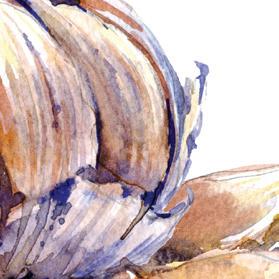
SEPTEMBER 9

Going Bananas
Local songstress Andriana Chobot leads the latest installment of the Flynn’s free, family-friendly Saturday morning series in Burlington. During FLYNNZONE KIDS HOUR: ANDRIANA & THE BANANAS, the former piano teacher and her crew get kids moving, grooving and singing along with a fun, interactive performance that incorporates elements of jazz, pop, rock and folk. Saturday, September 9, 10 a.m., at the Flynn in Burlington. Free. Info, 863-5966, flynnvt.org.

SEPTEMBER 30
Fall It a Day


OCTOBER 7

Guitar Heroes

Stowe Vibrancy presents INDIGENOUS PEOPLES’ DAY ROCKS!, a festival and concert celebrating Native American culture and traditions. The day kicks o with a blessing from Chief Don Stevens of the Nulhegan Band of the Coosuk Abenaki Nation. Stay tuned for musical acts; past installments have featured Blues Hall of Famer Joe Louis Walker and Washington, D.C., jazz legend Carly Harvey.
Saturday, October 7, 10:30 a.m.-6:30 p.m., at Mayo Farm Events Field in Stowe. Free; donations accepted. Info, 503-5771, stowevibrancy.org.

SEPTEMBER 24





History in the Making
History bu s and lovers of an oldfashioned fall festival converge on the Old Stone House in Brownington for the annual ALEXANDER TWILIGHT DAY. This year’s celebration marks the 200th anniversary of Twilight’s graduation from Middlebury College — making the future first Black state legislator also the first Black American to earn a bachelor’s degree.
Sunday, September 24, at Old Stone House Museum & Historic Village in Brownington. Free. Info, 754-2022, oldstonehousemuseum.org.

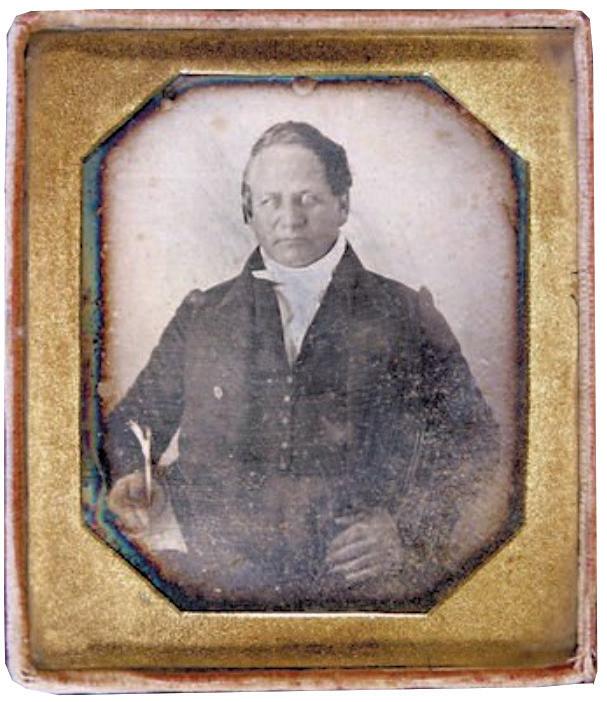
The petite Northeast Kingdom village of East Burke throws its largest annual shindig, the BURKE FALL FESTIVAL, on the last Saturday of September. The village green is replete with all-ages rural delights, including horse-drawn wagon rides, a farm animal petting zoo, cow plop bingo, rubber ducky races, a book sale and a craft fair featuring more than 70 vendors.
Saturday, September 30, 10 a.m.-3 p.m., at various East Burke Village locations. Free; fee for some activities. Info, 626-4124, burkevermont.com.

OCTOBER 1
The Smashing Pumpkins
Start building your trebuchets now: The VERMONT PUMPKIN CHUCKIN’ FESTIVAL is back. Competitors using homemade catapults compete to see who can hurl a squash farthest across Stowe’s Mayo Farm Events Field. Meanwhile, a more peaceful but no less ruthless chili cook-o keeps spectators fed. Don’t miss the fest’s first-ever craft fair.

Sunday, October 1, 11 a.m.-4 p.m., at Mayo Farm Events Field in Stowe. $10; free for kids 5 and under. Info, 603-630-4800, vtpumpkinchuckin.blogspot.com.

Allium You Can Eat


Downtown Bennington transforms into GARLIC TOWN, USA, an annual celebration of all things allium and a stinkin’ good time. Between live music, magic shows, face painting and trivia, vendors serve up scrumptious specialties such as garlic scape pickles, funky aiolis, black garlic salt and wearable garlic crowns.
Saturday, September 2, 10 a.m.-5 p.m., at various Bennington locations. $5-12; $30 for family bundle. Info, 447-3311, garlictownusa.com.
OCTOBER 29
Ghouls Just Wanna Have Fun
Ghosts and goblins of all ages don costumes for A FAMILY HALLOWEEN at Billings Farm & Museum in Woodstock. Kids and grown-ups alike will enjoy not-too-spooky activities such as trick-or-treating, costume parades, hayrides, the Sunflower House, crafts, pumpkin bowling, and sweet treats such as cider doughnuts and pumpkin ice cream.
Sunday, October 29, 10 a.m.-5 p.m., at Billings Farm & Museum in Woodstock. Regular admission, $10-17; free for members, kids in costume, and kids 3 and under. Info, 457-2355, billingsfarm.org.

KIDS VT FALL 2023 15
Joe
Louis Walker COURTESY OF ARNIE GOODMAN
SEPTEMBER 2
Andriana Chobot
A Family Halloween
FIND FAMILYMORE FUN
WEEK
calendar, or online atsevendaysvt.com/ familyfun
Pumpkin Chuckin’ Festival
EACH
in the Seven Days
COURTESY OF DAVE JORDAN
COURTESY OF LYRIC THEATRE
Borani Kadoo and Bolani
An easy Middle East-inspired meal
BORANI KADOO
Ingredients
• 2-3 pounds butternut squash or sugar pie pumpkin, peeled, deseeded and cut into 1-inch chunks
2 tablespoons vegetable oil 1/3 cup sugar
• 1/3 cup maple syrup (or use sugar for a more authentic dish)
• 2/3 teaspoon ground cinnamon
Directions
1. Preheat oven to 350 degrees.
2. Heat a large Dutch oven or other oven-safe pot over medium-high heat. Coat cut squash or pumpkin evenly in oil. Add to the pan and cook for about 5 minutes, until lightly browned, stirring often.
3. Remove pot from heat and add sugar, maple syrup and cinnamon, stirring to coat. Cover and cook in the oven for about 30 minutes, until tender.
4. Serve warm with the yogurt and tomato sauces. (See recipes at right.)
GARLIC YOGURT SAUCE
Ingredients
• 1 cup plain yogurt
• 1 clove garlic, crushed
Directions
1. Combine garlic and yogurt thoroughly.
2. Refrigerate at least 1 hour to allow flavors to combine.
SPICED TOMATO SAUCE Ingredients
• 1 tablespoon vegetable oil
1 large onion, finely chopped
2 cloves garlic, chopped
• 2 teaspoons ground coriander
• 1 tablespoon ground turmeric
• 1 teaspoon ground black pepper
• 2 cups plain canned tomato sauce
• 1/2 cup water
Directions
Looking for a creative way to serve pumpkins and butternut squash this fall?
I recently discovered one: Over the summer I visited friends in Baltimore who brought me to a fantastic Afghan restaurant. They suggested I try their favorite dish, which consists of sweetened pumpkin or squash served with a spiced yogurt sauce. It was absolutely delicious, and I knew that I had to try making it.

While researching the dish, I found that it’s often served with both a yogurt sauce and a spiced tomato sauce. The pumpkin or squash is usually baked with sugar, but I put a Vermont spin on it by substituting maple syrup instead. I wanted to make a full meal, so I added a versatile unleavened Afghan stuffed flatbread called bolani. There are so many relatively easy-to-make variations, including vegetarian and meat options. I opted for a filling with lots of veggies, including potatoes, spinach and scallions — plus ground chicken, cilantro and delicious spices. An added bonus: The bolani can be packed into lunches and served at room temperature!
The flatbread can be made ahead of time: Just wrap the dough tightly in plastic wrap or aluminum foil and refrigerate it. It’ll be good for 10 to 14 days. Once cooked and cooled, the stuffed bolani can be kept in the refrigerator for up to five days, or frozen for a few months.
The best part is that both of the sauces are also wonderful on the bolani. You may never have traveled to the Middle East, but this flavorful meal will bring your taste buds there. K
1. Heat a medium saucepan over medium heat. Add oil.
2. Cook onion and garlic until onion is translucent, stirring often, about 5 minutes.
3. Add spices and cook until fragrant, about 2 minutes.
4. Stir in tomato sauce and water and simmer for about 20 minutes, or until the sauce is thickened.
KIDS VT FALL 2023 16 PHOTOS: ANDY BRUMBAUGH
MEALTIME BY ASTRID HEDBOR LAGUE
Borani Kadoo
BOLANI (STUFFED AFGHAN FLATBREAD)



Ingredients

Dough
• 3 cups all-purpose flour
• 1 cup water
• 3 tablespoons vegetable oil
• 1 teaspoon fine salt
Filling
• 4 large Yukon Gold potatoes
• 1 cup frozen chopped spinach, thawed and squeezed dry
• 1/2 cup finely chopped scallions
• 1 cup finely chopped cilantro
Directions
1. Knead together the ingredients for the dough until a smooth ball forms. Wrap in lightly oiled plastic wrap and allow to rest for at least 30 minutes at room temperature.
2. Boil or cook potatoes in a microwave oven until soft. (I cooked them in my Instant Pot on high pressure for 10 minutes. If you are boiling on the stovetop, you can peel and chop into chunks before boiling.) Cool slightly, then peel off the skin and put the cooked potatoes in a large bowl.
3. Mash potatoes together with spinach, scallions and cilantro.

4. Heat the tablespoon of oil in a sauté pan over medium-high heat. Add spices and cook, stirring, until fragrant, 1 to 2 minutes. Add ginger, garlic, salt and pepper and cook for an additional minute.
5. Add ground chicken to the spices in the pan and cook until the chicken is lightly browned and cooked through, stirring occasionally.
Happy New School Year!
From the 12,000 members of Vermont-NEA — teachers, paraeducators, cafeteria workers, bus drivers, custodians, school nurses, librarians, and counselors — welcome to the 2023-24 school year.

• 1 tablespoon vegetable oil


• 1 teaspoon ground cumin
• 1/4 teaspoon garam masala
• 1/2 tablespoon finely minced fresh ginger
• 1 tablespoon finely minced garlic
• 1 teaspoon fine salt (more to taste)
• 1/2 teaspoon ground pepper
• 1/2 pound ground chicken
• vegetable oil for frying

While we are still living in extraordinary times, one thing hasn’t changed, and won’t: Our steadfast commitment to our schools, our communities and, most importantly, our students.
6. Combine the spiced meat with the potato mixture.
7. Divide the dough into 8 equal balls.
8. Roll each ball into a rough 6- to 8-inch circle.
9. Scoop about 1/3 cup of the filling mixture onto one half of each circle, leaving about 1/2 inch around the edge.

10. Wet the edges of the circle with just a little water, then fold over and press edges together to close tightly. Flatten each half circle slightly so they are of an even thickness.




11. Heat a large pan (cast iron preferred) or griddle over medium-high heat. Add just enough vegetable oil to coat the pan, then fry the flatbread for about 3 minutes on each side, until lightly brown. (If you can, use another pan on top, with parchment paper under it, to press down the flatbreads, so they cook evenly). Turn the heat down if they get dark brown. Continue until all flatbreads are cooked.

KIDS VT FALL 2023 17
vtnea.org k2v-VTNEA082323.indd 1 8/18/23 4:22 PM
Together, we ensure our public schools remain Vermont’s most important resource.
TURNING THE PAGE
The Children’s Literacy Foundation inspires kids to read, one book at a time
BY GILLIAN ENGLISH
Usually people go to the library to borrow books. But on Thursday, August 10, a group of about 20 kids at the Fletcher Free Library in Burlington got to pick out two titles to take home for keeps.
The young readers, including a number of kids from nearby King Street Center, had come to hear a reading of the book Soccer Star by Mina Javaherbin. It’s the story of a Brazilian boy who dreams of being a famous soccer player.
The reader: Duncan McDougall, founder of the Children’s Literacy Foundation. The Waterbury-based nonprofit, also known as CLiF, aims to inspire kids under 12 to love reading and writing. It partners with schools and libraries in Vermont and New Hampshire to put on events like this one, which celebrated the end of the library’s summer reading program.
“We love how exciting and engaging all of CLiF’s presenters are,” said Megan Estey Butterfield, youth library manager.
At the end of the presentation, each young audience member got to pick out two books to take home from a selection provided by CLiF. Giving away books has been a core part of the nonprofit’s existence since McDougall started it in 1998; since then, CLiF has given away books worth more than $10 million.

“When you own your own book and it belongs to you, that’s really special,” Butterfield said. “We love that we can be part of that experience, too.”
Though McDougall was the reader that day, he no longer heads the organization. On March 1, longtime board member Laura Rice took over as executive director. She was at the library that day, too, along with communications manager Sarah Hall.
Earlier in August, I talked with Rice and Hall about how CLiF is helping schools and parents raise readers and how it’s responding to challenges such as the flooding this summer.
On taking over as the director:
Rice said that when she took the helm at CLiF, her kids told her that she found her “true home.” Her three children — now adults — have fond memories of regular library visits and book-reading snuggles with their mom. Always an avid reader herself, Rice also loved writing and
kept detailed diaries throughout her childhood.
While working in leadership roles for other nonprofit organizations, Rice served on CLiF’s board from 2014 to 2021. She was taken with CLiF’s mission not only to give children more access to books but also to show them the joy of reading, which has been so important to her.
“I feel fortunate to have grown up with books as very much part of my life,”
she said. “It was serendipitous to be able to bring my professional background to an organization that I so deeply care about.”
On responding to challenging times:
The July flood didn’t damage CLiF’s new headquarters, on Route 100 in Waterbury, but the surrounding community was hit hard. So were many libraries — 17 of them across the state
suffered flood damage. The KelloggHubbard Library in Montpelier lost around 10,000 books as a result of eight feet of standing water in the library’s basement.
After taking her 9-year-old daughter out to view the destruction caused by flooding in Vermont, CLiF program manager Cassie Willner wrote a blog post about how difficult it can be for young kids to talk about their feelings after these kinds of disasters. She compiled a list of books with a message of resiliency, such as Wildfire! by Vermont author Ashley Wolff (see sidebar).
Children don’t always have the vocabulary to express what they’re thinking and feeling, and books can be a great tool for them to recognize their own emotions, Hall said. CLiF has been trying to provide more books with these themes to kids.
On Year of the Book:
During the school year, CLiF selects a group of elementary and middle schools in Vermont and New Hampshire for its flagship grant program, called Year of the Book. Schools apply for the program; 15 were chosen for the 2023-24 group, including schools in White River Junction, Pownal, Glover, Hardwick and Randolph.
Year of the Book is a customizable resource that includes $25,000 worth of literacy programming. CLiF provides 10 new books to every child in the school, and it offers a variety of literacy-related programs. Which ones educators use is up to them, Hall said.
“We have a roster of these amazing, creative people that give presentations to the children that spark interest, awareness. There are so many reasons why kids have negative feelings around literacy, and we try to build positive feelings instead with high-quality resources and presentations,” Hall said.
Last year, Hall helped an elementary school organize a reading challenge as one of the ways to use the funding. If the students reached a cumulative number of books read, they got to take a trip on the Cog Railway up Mount Washington. The students successfully completed the challenge and took the trip in June, amazed to see snow on the top of the
KIDS VT FALL 2023 18 TURNING THE PAGE, P. 20 »
PHOTOS: LUKE AWTRY
Children checking out free book options at a CLiF event at Fletcher Free Library
STORIES OF RESILIENCE
After seeing the devastating flood damage in Vermont, CLiF program manager Cassie Willner compiled a list of books that exemplify strength and adaptability in kids confronted with natural disasters. Here are four of them:


I Am the Storm by Jane Yolen and Heidi E. Y. Stemple; illustrated by Kristen and Kevin Howdeshell (2020)

Ages: 3 to 7 years
This picture book offers examples of four distinct weather emergencies (tornado, blizzard, forest fire and hurricane) with reassuring family stories of finding comfort in preparedness and resilience. This book was also a Vermont Red Clover nominee for 2021-22.
Wildfire! by Ashley Wolff (2021)


Ages: 3 to 8 years

With artwork by Vermont-based authorillustrator and CLiF presenter Ashley Wolff, this fact-based picture book takes readers into the heart of a forest fire and shows how animals survive, how firefighters curb the flames, and how life can and will return to the forest. It’s useful for students to learn about the natural world’s ability to recover after a disaster.

A Place Where Hurricanes Happen by Renée Watson; illustrated by Shadra Strickland (2014)

Ages: 5 to 9 years
Children of New Orleans tell about their experiences of Hurricane Katrina through poignant and straightforward free verse in this fictional account of the storm.
As natural and manmade disasters become commonplace, we increasingly need books like this one to help children contextualize and discuss difficult and often tragic events.
The Puttermans Are in the House by Jacquetta Nammar Feldman (2023)



Ages: 8 to 12 years
This fiction chapter book follows 12-yearold twins and their family’s hardships after Hurricane Harvey. It’s a coming-of-age story with themes of acceptance, family relationships, hope and baseball.
Find Willner’s full list at clifonline.org/ after-the-flood-helping-kids-find-resiliencethrough-literature










KIDS VT FALL 2023 19
Scientific, Technical, Engineering, Visual and Performing Arts, Service Learning, and Early Learning. Community and school-based teams for age 4 -college S T E A M SCIENCE TECHNOL0GY ENGINEERING ARTS MATHEMATICS ON A TEAM! 802 272-2766 • VTDICREATIVITY@GMAIL.COM DESTINATIONIMAGINATION.ORG • CREATIVEIMAGINATION.ORG START A TEAM TODAY! START A TEAM TODAY! k6h-DestinationImagination0822.indd 1 8/8/22 6:11 PM Barre, VT All inquiries: info@mscvt.org or (802)-479-0912 www.mscvt.org A child-centered alternative education, dedicated to the philosophy and teachings of Maria Montessori. Children ages 18 months to age 12 *A prequalified, 5 STAR program accepting Act 166/ Universal PreK funding. k8v-MSCVT0820.indd 1 8/25/20 10:20 AM See a Teddy Bear Come to Life! 6655 Shelburne Rd. Shelburne, VT 05482 Visit www.VermontTeddyBear.com or call 1-800-829-BEAR for store hours & tour information TAKE A BEAR FACTORY TOUR! $5 OFF YOUR PURCHASE of $50 or more. 1 coupon per customer. Coupon cannot be combined with any other o er. Member of Vermont Attractions Association VTAttractions.org k8v-VTTeddyBear020123.indd 1 1/25/23 4:07 PM SIENNA FLANDERS, LM, CPM WWW.8GENERATIONS.COM k12h-8generationsBirthServices030123.indd 1 2/3/23 2:08 PM
mountain. One of CLiF’s presenters, Erik Pinder, who is the author of the children’s book Cat in the Clouds, works at the Mount Washington Observatory and joined in on the excursion.
Said Hall: “These kids had an experience that was created as a result of their reading. That was a powerful connection.”
On connecting libraries and schools:
Throughout the year, CLiF also works with libraries through the Rural Library Grant, which provides $2,000 in books for the community’s public library, $500 for the local public school library, as well as storytelling presentations, author visits and book giveaways for kids.
“I’ve heard from a lot of these libraries that this programming has really helped kids reengage with them post-pandemic,” Rice said.
Butterfield of Fletcher Free Library recalled that last year’s collaboration between CLiF, the Fletcher Free Library and Edmunds Elementary School was particularly effective.


Jason Chin, a Caldecott Medalwinning children’s book author, was the presenter, and he shared a story about an author talk he attended as a child. It was with children’s book author Trina Schart Hyman, who inspired him to work on his art.
“It just made me think that we could have the next Caldecott winner here in this group of kids, and they could be seeing that their own dream is possible, too,” Butterfield said.

On encouraging reading at home:
One of the best ways to get a child interested in reading is by allowing them to choose their own books, Rice said.
“When they choose what they wish to read, show interest and support their choices,” she added.

Hall said that when her daughter was an early reader, she gravitated toward comic books and graphic novels. Parents can see that as a “cop-out,” but Hall emphasized how wrong that is. “Reading is reading, and we should encourage kids to read whatever brings them joy.”
Another great way to encourage reading, Rice said, is to sit and read with a child. Even if a caregiver doesn’t have high literacy skills, sitting with the child and starting conversations about the content in the book can make a big difference in encouraging them to read more.
She also recommended making outings to a library or bookstore part of a child’s life. If they associate positive memories with books, they’re more likely to pick them up into adulthood.
How you can help CLiF’s literacy efforts:

CLiF is founded entirely by private donations and grants — the organization does not receive any federal funding. Beyond donating money to CLiF, Rice said that when people host book drives, it makes a big difference.
“Brand-new, high-quality books are always appreciated,” she said.
Find a guide to hosting book drives for CLiF at clifonline.org/host-a-bookdrive. K
KIDS VT FALL 2023 20
TURNING THE PAGE CONTINUED FROM P.18
PHOTOS: LUKE AWTRY
WHEN YOU OWN YOUR OWN BOOK AND IT BELONGS TO YOU, THAT’S REALLY SPECIAL. MEGAN
ESTEY BUTTERFIELD
You belong at the Y! With a Family Membership to the Y, you can • enjoy time in the pool during Family Swim • have fun in the gym during Open Rec or Family Rec • join a Group Fitness class with your child age 13 and older • take time to yourself working out on-site while the kids age 6 months - 8 years are safe and happy in Member Child Care Members register early + receive discounts on programs. Stop by for a tour @298 College Street gbymca.org NO JOIN FEE, Aug.15to Sept.30! k3h-GBYMCA082323 1 8/16/23 1:21 PM
Children selecting two free books to keep





















Get the newsletter featuring notable news, arts and food stories handpicked by our editors. Sit back, relax and read up on what you may have missed. SUBSCRIBE TODAY: SEVENDAYSVT.COM/ENEWS And on the seventh day, we do not rest. Instead we bring you... 4h-sundaybest-dog.indd 1 3/2/21 6:43 PM Health. Organic foods. Co-op discounts. Creative recipes. Good habits. Parents give WIC Parents GIVE Give WIC to your family. The benefits are bigger than you think. HealthVermont.gov/WIC k3/4h-SmallMammal(WIC)082323.indd 1 8/18/23 12:28 PM KIDS VT FALL 2023 21
What can you do to improve your community?
Take the Challenge and find out!
We can do great things when we work together. We can construct buildings and monuments, pass laws, organize support for neighbors in need, and create inviting public places to learn, relax and play. We can share our work with each other through trusted local news sources — on TV, radio, in print and online — and inspire others to take action, too!
This summer’s Good Citizen Challenge asks K-8 students to learn about their communities — and current events — and find ways to lend a hand.
Complete the Challenge by September 4, 2023, for a chance to win a $100 gift card to Phoenix Books and a FREE trip for two to Washington, D.C., from Milne Travel!
All who finish the Challenge will receive a Good Citizen sticker and patch, a pocket-size U.S. Constitution, and an invitation to a VIP reception at the Vermont Statehouse this fall.
INSTRUCTIONS
1. Complete a horizontal, vertical or diagonal row of five activities.
2. Mark each completed box, and snap a photo of each activity to show evidence of your work.
3. Upload a photo of your completed scorecard, and evidence of your work, at goodcitizenvt.com. Or mail the scorecard and evidence, along with your name and contact info, to: Seven Days/Kids VT Attn: Good Citizen, PO Box 1164 Burlington, VT 05402-1164
KIDS VT FALL 2023 22 2 “Freedom and Unity” 1 Remember This 23 The Social Dilemma 17 Oldest Building 14 Organize Support 15Room Where It Happens 16 Watch the News 19 What’s in a Name? 20 Running for Office 3Clean Up 5 Pitching In 9See the Spot VISITYOUR LOCALLIBRARY • V I RUOYTIS YRARBILLACOL • FREE 8Stay Safe 18 Museum Piece 22 Deed Search 12 Shop Local 6Who Turned on the Lights? 7 Connect With Neighbors 11 Think Globally 10 Read the Paper 4 Get Together 13 Blast From the Past 21 Listen to the News 24 Take Control SCORECARD 2023 Open to all K-8 students
NEW THIS YEAR: The library that helps the most K-8 students
Challenge and
library
participants submit the highest-quality
win a $500 cash prize — funded by a grant from Vermont Humanities — to be used to promote civicthemed resources or programming. SHARE YOUR PROGRESS AND INSPIRE OTHERS! • Upload high-quality photos of your work to goodcitizenvt.com. We’ll publish the best entries in Kids VT or Seven Days. • Spread the word about the Challenge by sharing your work with your community newspaper, either as a letter to the editor or as an article submission. • Post about the Challenge on your neighborhood Front Porch Forum, or, if you’re under 14, ask an adult to post for you. LEARN ABOUT VERMONT • HAVE FUN • HELP OTHERS JOIN THE FUN AT GOODCITIZENVT
finish the
the
whose
work will each
. COM
Some of the activities completed so far...

#1 REMEMBER THIS


Public memorials commemorate events a community wants everyone to remember. Visit a memorial near where you live and find out who it honors and why.
“I picked the 9/11 memorial in the cemetery near my house. The memorial is to honor those who died in the World Trade Centers, Flight 93 and the Pentagon. Above the memorial is a piece from one of the World Trade Centers. The words written on the stone are, ‘May we never forget.’ This means that we must never forget those who died and those who sacrificed themselves to save others. I learned what Americans can accomplish when they come together.”
— Harriet Sterling, Fair Haven

# 23 THE SOCIAL DILEMMA







Listen to the episode of “But Why: A Podcast for Curious Kids” titled: “Why Is Social Media So Addictive?” and tell us what you learned.

“I learned that the social media companies collect what people like or get sucked into for hours and then show that person more of that same content.”






























 — Charlotte Krueger, Je ersonville
— Charlotte Krueger, Je ersonville
#14 ORGANIZE SUPPORT
Gather donations for a local nonprofi t or charity of your choice. Expand your impact by using Front Porch Forum.




From a Front Porch Forum post by Emily Mars Raymond, Hinesburg:
“My fi fth grader, Oliver, is doing the Good Citizen Challenge this summer and one of the tasks is to organize support for a charity. Oliver would like to collect donations of nonperishable food for Hinesburg’s Little Free Pantry. Have a bag or box of food you keep forgetting to drop at the pantry? We will come pick it up from you!”


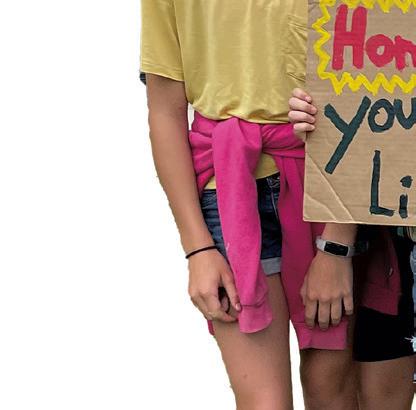

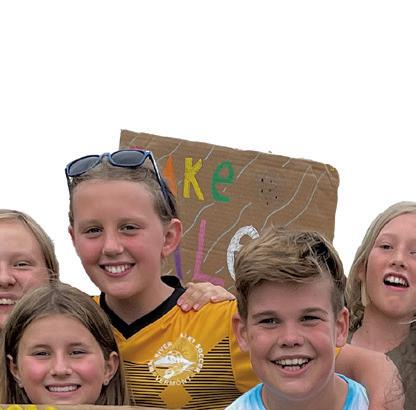


From a Front Porch Forum post by Christopher Foley of Colchester: “Riley Foley, age 9, is participating in the Seven Days Good Citizen Challenge. Riley is organizing a drive to supply hygiene kits to the COTS program for the unhoused. Between 8/7/23 and 8/21/23, you can help by donating any of the items on their wish list, including: razors for shaving, body wash, shampoo and conditioner, deodorant and mini toothpastes.”


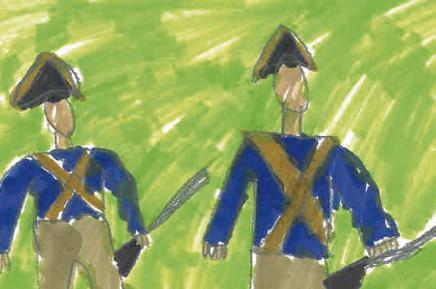


A group of Morrisville students are doing the Challenge through the Morristown Centennial Library. In July they hosted a bake sale fundraiser to benefit the Johnson Public Library, which was damaged in the floods. They announced it on Front Porch Forum, and the local bridge club responded with donations and some baked goods. In one hour, they raised $539.
#7 CONNECT WITH NEIGHBORS

Join your neighborhood’s Front Porch Forum — or, if you’re under 14, have an adult in your household subscribe — and contribute a post sharing something you’ve learned about your community while doing the Challenge.



“I’ve been participating in the Good Citizen Challenge, and it has made me connect with my community and people who keep our community safe and people who volunteer in our town. I’ve learned about my town’s history, and now I appreciate where we are today more.”
— Charlotte Krueger, Je ersonville








KIDS VT FALL 2023 23
Challenge Organizers Partners Underwriters
The Evslin Family Foundation
Hinesburg’s Little Free
for
A group of Morrisville
Johnson
SEE
In one hour, they raised $539. #9
THE SPOT
ENTER BY SEPTEMBER 4, 2023, FOR PRIZE ELIGIBILITY SEE INSTRUCTIONS AND SUBMIT YOUR ENTRIES AT GOODCITIZENVT.COM Got questions? Contact us at goodcitizen@sevendaysvt.com or 802-865-1020, ext. 114.
Visit a state historical marker and draw a picture to show us your interpretation of the person, place or event it depicts.

KIDS VT FALL 2023 24

KIDS VT FALL 2023 25







































































































































































































































































































































































A Supercharged Day of Family Fun Saturday 10am-2pm September 23 585 Pine Street rain date September 24 more at burlingtonelectric.com Energy Expert Advice Vendor Demos EV Test Drives E-Bike Test Rides Meet CHAMP! Kids Games Food & Ice Cream DJ & Live Music Reduce Fossil Fuel Use & Save Money! RAFFLE PRIZES Get one free ticket and enter to win an e-bike, electric lawn tools, shopping trolleys, & more prizes generously donated by k2v-BurllingtonElectric082323 1 8/10/23 3:21 PM STEAM BACKPACKS VINS NATURE CENTER / QUECHEE, VT / 802.359.5000 / VINSWEB.ORG 6 Themes Options for Grades K-8 Activities, Games, Books, Tools, and More! At least 15 items per Backpack RENT A BACKPACK Farm Market • Bakery • Greenhouses VERMONT & SPECIALTY FOOD PRODUCTS MAPLE SYRUP, HONEY, JAMS, MUSTARDS, DRESSINGS & MORE HEY KIDS! COME ON OUT & HAVE SOME FUN APPLE CIDER DONUTS DAILY! GIANT PUMPKIN WEIGH-IN Sat. Sept.16th 12pm-3pm Visit Facebook for info about other Fall Activities. MAZZA’S 8 ACRE CORN MAZE Open Daily starting early September. Buy your tickets at sammazzafarms. mazeplay.com HAYRIDES TO THE PUMPKIN PATCH Weekends 11am-4 pm starting Late September 277 Lavigne Rd., Colchester • M-Sa 7am – 7pm Sun 7am – 6pm 802-655-3440 • sammazzafarms.com Kids Costume Dance Party Sat. Oct. 28th 10am-12pm K6h-sammazza0823.indd 1 8/21/23 9:21 AM 2095 Pomfret Rd, So. Pomfret, VT | 802-457-3500 AFTER SCHOOL, HOMESCHOOL TODDLER PROGRAMS + MORE! community arts center, theatre & gallery artistreevt.org 2095 Pomfret Rd, So. Pomfret, VT | 802-457-3500 k6h-Artistree082323.indd 1 8/18/23 4:20 PM KIDS VT FALL 2023 26
KIDS JUST FOR


Coloring Contest!



Three winners will each receive four passes and animal stickers from ECHO, Leahy Center for Lake Champlain. Send Kids VT your work of art by November 1. Be sure to include the info at right with your submission. Winners will be chosen in the following categories: (1) ages 5 and younger, (2) ages 6-8 and (3) ages 9-12. Winners will be named in the Winter issue of Kids VT. Send your high-resolution scans to art@kidsvt.com with “coloring contest” in the subject line, or mail a copy to Kids VT, P.O. Box 1184, Burlington, VT 05402.
SPONSORED BY:
Each age category winner will receive: 4 ECHO passes and ECHO animal stickers!

KIDS VT FALL 2023 27
Title Artist Age Town Email Phone
COLORING CONTEST WINNERS

Our judges were elated with the exemplary submissions mailed in as part of this month’s coloring contest. Annika, 9, brightened her lovely creation with swirling rainbows and added mini elephants. Six-year-old Legend sent us a striped elephant ready to dive for peanuts. Georgia, 5, submitted an elephant decked out in pink and pumped up to do yoga. Thanks to all who entered! We can’t wait to see what you have in store this time.



HONORABLE MENTIONS







“THE RAINBOW FLASH”
James Boehm, 5 Burlington
“JUST CLOWING AROUND”
Ayriana Witter, 11 Burlington

“BEACH PARTY”
Frances Barbot, 5 Williston
“RAINY DAY”

Jolene Waldron, 5 Essex
“PARTY TIME”
Emily Blais, 9 Colchester
“FUN IN THE SUN”
Hanna Stormer, 9 Waterbury
“MAMA ELEPHANT”
Evelyn Miller, 8 Hinesburg
“MR. MISMATCH”
Rose Witherspoon, 11 Montgomery
“ELEPHANT UNDERWATER”

Simone Brandau, 5 Fairfield



TOP TITLES












“ELLE-PHANT RAINBOW”
Evelyn Duval, 5 Colchester

“ELLA BELLA”
Emma, 5 Burlington
“ELLIE”
Ania Carr, 6 Underhill

The winners of 4 ECHO passes, 4 Champ creemees and ECHO animal stickers are…







KIDS VT FALL 2023 28
“Love Makes Rainbows” Annika Tripp, 9 South Hero 9 to 12 “Will Dive For Peanuts” Legend Vartuli, 6 Colchester 6 to 8 “Ellie Does Yoga” Georgia Helson, 5 Weybridge 5 & under
WATER+ADVENTURE SPEAKER SERIES Kids 12+under FREE ADMISSION 50% o Student Discounts SEPT. 2, 2023 11AM-6PM Hula | 50 Lakeside Ave. | Burlington For more info, visit communitysailingcenter.org k16-LCCSailingCenter082323.indd 1 8/17/23 5:47 PM 1/27/11 11:33 AM Find, fix and feather with Nest Notes — an e-newsletter filled with home design, Vermont real estate tips and DIY decorating inspirations. Sign up today at sevendaysvt.com/enews. sponsored by obsessed? 4T-NestNotes-filler-21.indd 1 4/6/21 11:55 AM SQUISHY STUFF, SPARKLY THINGS CLOTHES TO WEAR, SHOES TO TRY ON CANDY TO EAT, GAMES TO PLAY PUZZLES TO SOLVE PLAYMOBIL & LEGO TO BUILD SQUISHMALLOWS & STUFFIES TO HUG MARKERS, CLAY, BACKPACKS, NESTING DOLLS, GIGGLES AND FUN 12 Main Street Bristol simonsaysvt.com • 453-6945 COME FIND IT ALL! k16t-SimonSays0523.indd 1 5/19/23 11:49 AM
KIDS JUST FOR
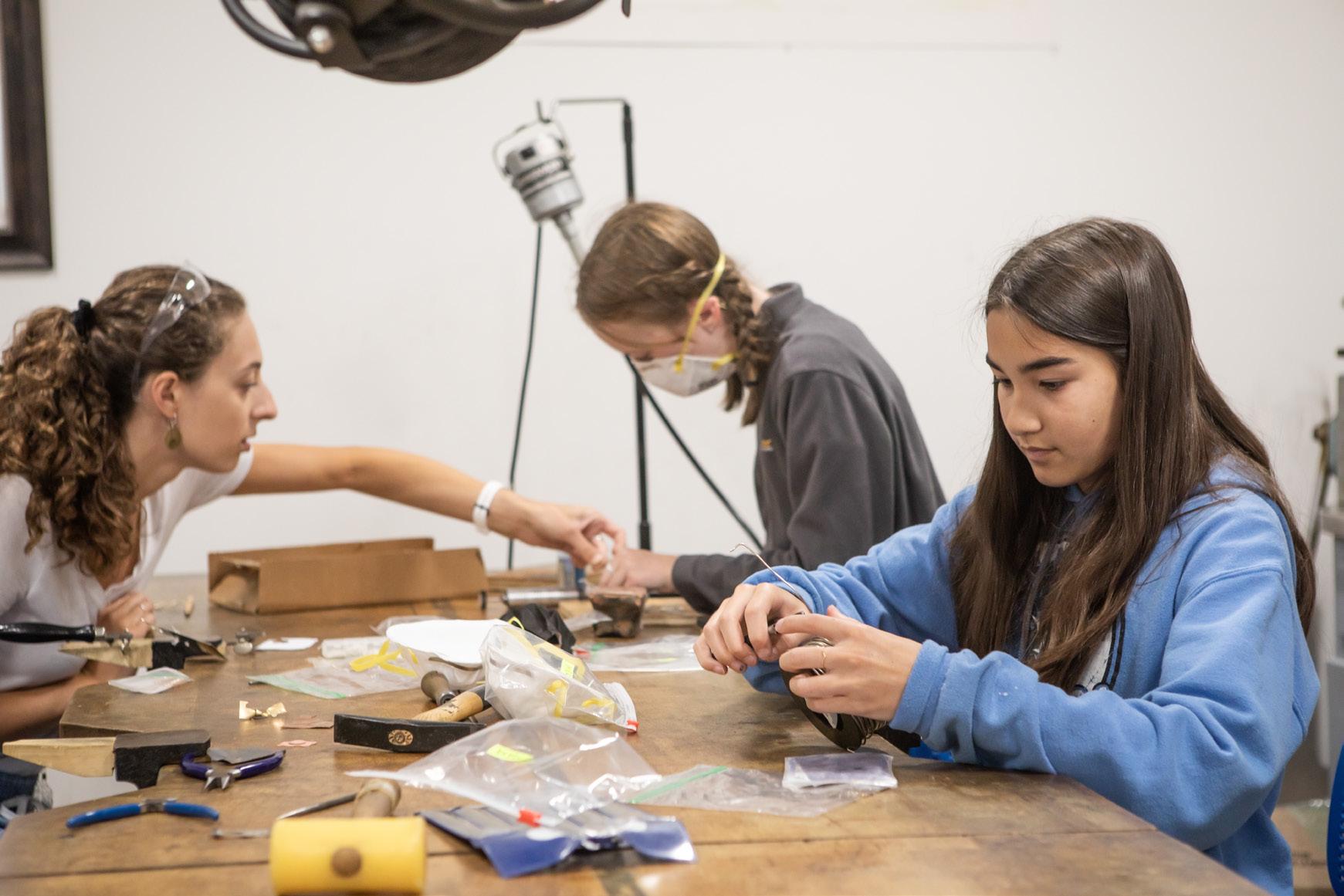






























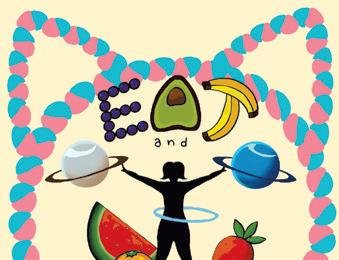

P: LUKE AWTRY Fall Youth, Teen & Family Classes REGISTRATION OPENS AUGUST 21, AGES 6 & UP Visit BURLINGTONCITYARTS.ORG or scan code to browse and register k4t-BCA082323 1 8/9/23 12:34 PM Be a Girl Scout. Be part of a crew that makes unforgettable memories together. Join your local Girl Scout community today! Your Year of F un ✓ Gear up for cool field trips. ✓ Make forever friends. ✓ Dream up a game to teach your troop. k4t-GirlScouts082323 1 8/9/23 12:33 PM Parties & Events P Parrttiies & Evennt t ts s Parties & Events Sensory Sensory Sensory Arts & Crafts Arts & Crafts Arts & Crafts Hula Hula Hula Hooping H Hooooppiinng gHooping and active a annd d a accttiivve e and active games! ga g mes! games! Fun with Fun with Fun with Foods! Foods! Foods! For everyone! For everyone! For everyone! BOOK NOW! BOOK NOW! BOOK NOW! S e p t e m b e r 4 N o v e m b e r 2 0 - 2 2 N o v e m b e r 2 4 Cooking Movement Art Making December 26-29 January 15 February 26-March 1 Kids Camps ages 5-14 2:30-5:30p Eat and Be hoopy University Mall 155 Dorset Street | South Burlington 802.355.8457 | eatandbehoopy.com k2v-Eat&BeHoopy082323.indd 1 8/11/23 11:43 AM KIDS VT FALL 2023 29
Readers help pay for the production of this award-winning weekly newspaper. Thousands have made one-time or recurring donations to sustain Seven Days since the beginning of the pandemic. Their support — along with advertisers’ — allows us to keep delivering breaking news and thoughtful long-form journalism to Vermonters.
Support local journalism — make a contribution today!





If you like what we do and can a ord to help pay for it, please become a Seven Days Super Reader. Your donation will help to keep our community informed and connected. Join the Super Readers at sevendaysvt.com/super-readers.
Or send a note (and a check) to: Seven Days c/o Super Readers PO Box 1164 Burlington, VT 05402


KIDS VT FALL 2023 30
Contact Kaitlin Montgomery at 865-1020, ext. 142 or superreaders@sevendaysvt.com.
PAULA ROUTLY 1t-PressOn-SR22.indd 1 1/24/23 5:21 PM
Seven Days on the press in Mirabel, Québec
Summit Not Required
Reconsidering the race to the top
Idon’t know about you, but I’m tired. For many of us, hiking a mountain is a refreshing and energizing rite of summer, but it was hard to get outside this year with all the heat and water, not to mention the Canadian wildfire haze. Heading into fall, I feel wrung out. These days, I often have energy for just a short, modest excursion.
So this fall, here’s a reminder you might need, too: You have permission not to summit. Getting to the top, admiring the view and taking photos can be satisfying, but it’s not always necessary. I’m not going to let myself feel guilty about missing out, and you shouldn’t either.
In my ecological planning graduate program, we joked about taking “field trips to the foothills of fabulous places” because we often didn’t make it to the main attraction. For example, in one of the first outings for my botany course, our instructors brought us to Rock Point in Burlington. I’m sure they’d planned to show us the spectacular cliffs overlooking Lake Champlain and the famous thrust fault that draws geologists from all over the world, but we barely made it out of the parking lot. We had so many questions!
Our teachers graciously answered them, allowing our curiosity to guide the discussion. That day we learned that the pigments that give flowers their hues are pH-dependent anthocyanins. Whether they’re red, blue or purple will depend on the acidity of the soil. We found out that
beets are colored by different pigments, called betalains — and so much more.
Since then, I’ve been back to visit the dramatic cliffs and beautiful bays many times. I even got married there. Our slow pace that day had no lasting repercussions.
Years ago I read an essay that stuck with me: “A Child’s Sense of Wildness” by author and ecologist Gary Paul Nabhan. In it, he recalls a time he brought his children camping in Arizona. The adults spent a lot of time looking for photo opportunities. Once they found one, Nabhan’s children would dutifully approach it with him. But upon arriving, the kids would immediately drop to the ground, distracted by pine cones, sparkly rocks and other interesting treasures.
He writes: “In retrospect, it is amusing to me that when I wished my children to have contact with wildness, I sent them ‘out,’ to climb high upon ridges and to absorb the grand vistas. Yet when they wished to gain a sense of wildness, of animal comfort, they chose not the large, but the small. In doing so, they may have been selecting a primordial connection with the earth and its verdant cover.”
This rings true for me. When I think about my own childhood, what I remember most is the hideout I made next to my back porch; climbing on rocks in a stream that ran next to the road in front of my aunt’s house; walking on my local bike path and stopping when I reached the grove of what were, to me at the time, giant trees.
It’s hard to get back to that childhood mindset, even when you have young children. I still remember a time when my then-toddler son stopped me while walking along the sidewalk, saying, reverently, “Wook, Mom, a swug!” I tried to be excited, oohing and aahing over it for a few moments. But we were running late, and it was hot, and I know I hurried him along to our destination.
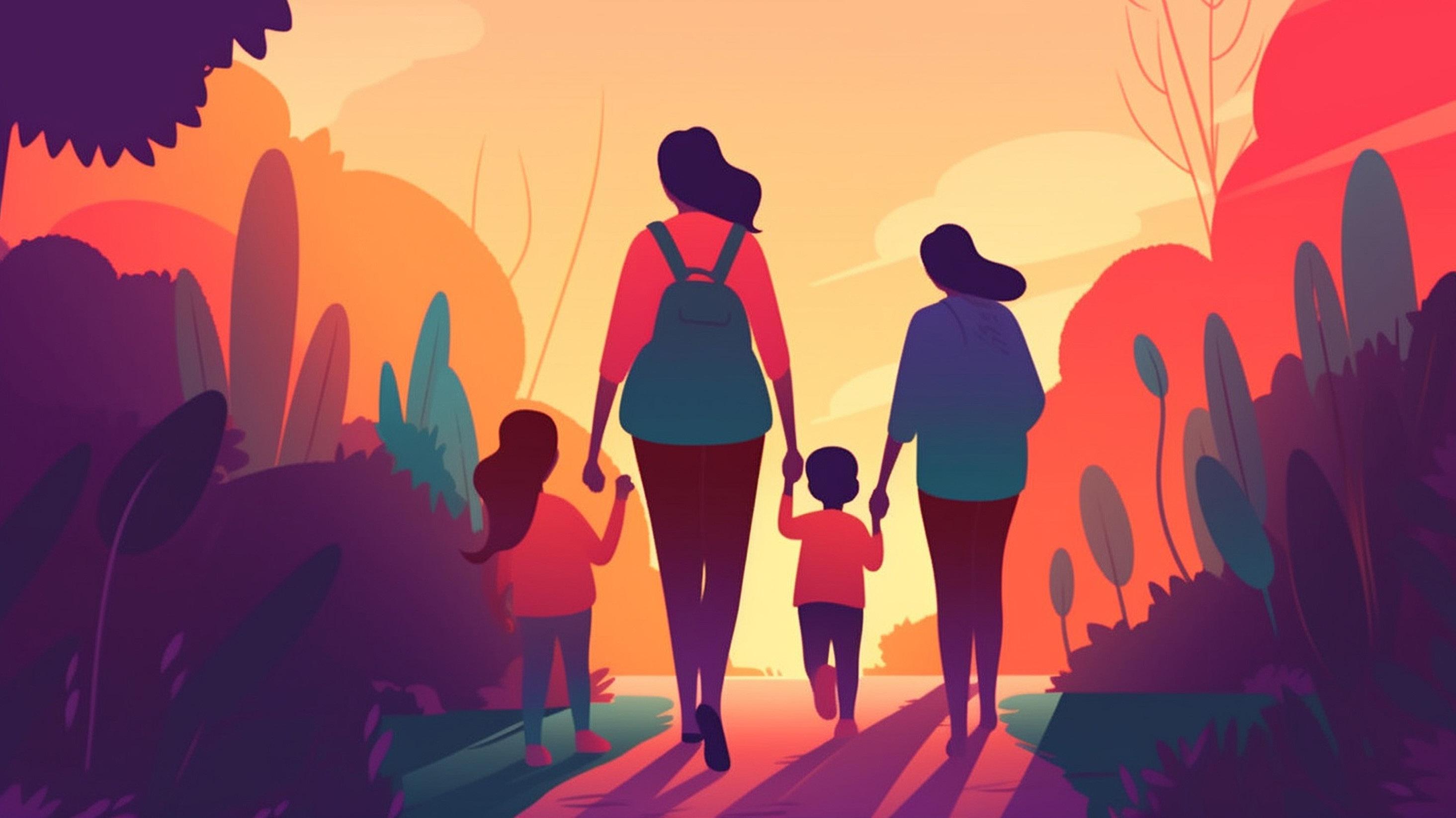
It can be hard to override the desire to push to the summit. Just this summer, an old friend visited with her kids, ages 14 and 10. I thought they’d enjoy climbing a mountain and seeing the beautiful view from the top. The kids were accommodating of my ambitious schedule, but it was a humid day, and the 10-year-old did ask a few times how much farther we were going as we dragged along.
I remember asking such questions
myself as a kid. It was my polite way of saying, “I’m not having much fun right now.”
I knew this, in some part of my brain, but another part insisted, “You have to learn that you can do this and how great it is!”
But did he? Honestly, if he were to look back on that day, he would probably think of it more fondly if we’d chosen a less ambitious destination. What if I had just taken them to a place where he could build a fort?
Here, then, is my countercultural advice: If you go to the Forest City trailhead in Huntington on a hot day and play around in Brush Brook to cool off but barely make it to the first bridge before turning around, it’s OK! If you set out to climb Snake Mountain but get distracted by the mysterious rusting farm machinery just a few short minutes up the trail, it’s OK! If you start climbing Mount Philo and your toddler fixates on a stick by the side of the road halfway up the trail and you take a seat while she pokes around with it until you’re both cranky and decide to head back, it’s OK!
It feels good to get to the top. But sometimes giving ourselves permission to stop is just as gratifying. K
Heather Fitzgerald writes Kids VT's "Good Nature" column. She teaches field ecology and environmental science at Saint Michael's College in Colchester and the Community College of Vermont.
KIDS VT FALL 2023 31
USE YOUR WORDS BY HEATHER FITZGERALD © LUCY GABOR DREAMSTIME
Getting to the top, admiring the view and taking photos can be satisfying, but it’s not always necessary.

k1-McKenzie082521 1 8/11/21 3:24 PM





















































































































 COLBY ROBERTS, COPUBLISHER
COLBY ROBERTS, COPUBLISHER













































































































































































































 — Charlotte Krueger, Je ersonville
— Charlotte Krueger, Je ersonville






































































































































































































































